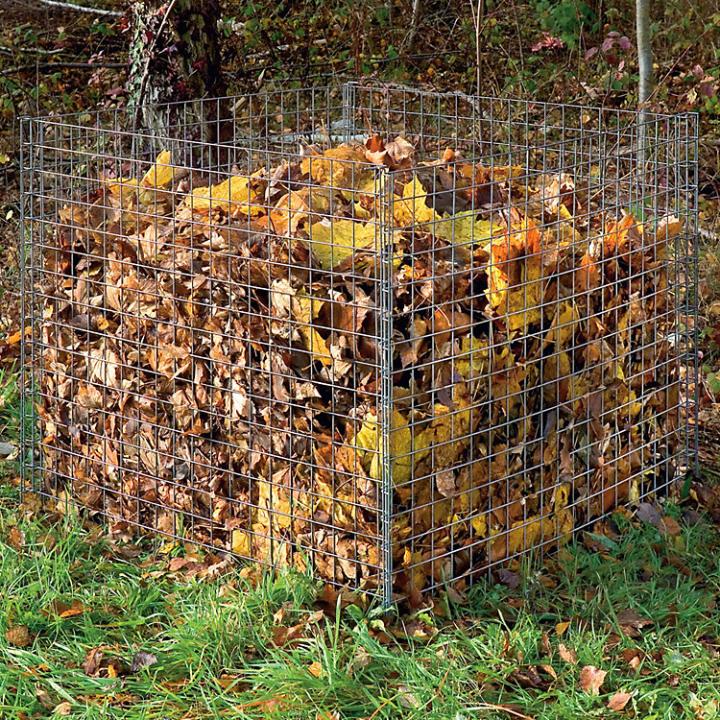How to Turn Fallen Leaves into Gardener’s Gold
What is leaf mold? It’s a much easier way to compost! Let leaves decompose into a dark, crumbly “gardener’s gold” for next year’s garden. Here are the very simple instructions on making leaf mold.
What is Leaf Mold?
You know how leaves start to naturally decompose in the woods? That’s leaf mold!
Leaves from deciduous trees simply fall and sit on the ground in autumn. Then they decompose into a dark, crumbly, earthy, soil-enriching mulch! It’s incredibly useful in the garden—to improve soil, suppress weeds, or as a component in your own potting soil mix.
This is different than traditional “hot” composting in which material breaks down through heat and bacteria. Making leaf mold is “cold” composting which is done primarily by fungi, rather than bacteria. While “cold” composting is slower than “hot,” it’s certainly easier.
In a nutshell, you collect a pile of leaves—as you’re probably already doing when you’re raking—but instead of throwing them into a trash dump, you save the leaf bags which will turn into an earthy hummus in a year or two.
Which Leaves Make Good Leaf Mold?
Most leaves are slightly acidic when they fall, with a pH below 6. However, as the leaves break down into leaf mold, the pH goes up into more a neutral range. Leaf mold will not correct pH problems, but will have a moderating effect.
Leaf mold is made from the leaves of deciduous trees and shrubs—i.e., the ones that drop their leaves before winter. (Thicker deciduous leaves and evergreen leaves take longer to rot down, so they should be added to a traditional compost heap where they’ll rot down faster due to higher temperatures.)
Some leaves should not be used for leaf mold, as they release chemicals that can stunt plant growth. These include black walnut, eucalyptus, camphor laurel, and cherry laurel.
Benefits of Leaf Mold
Leaf mold is great for retaining moisture in your soil as it holds 500 percent of its own weight in water. It absorbs rainwater to reduce runoff, and in hot weather, it helps cool roots and foliage.
Over time, annual applications of leaf mold mulch can significantly improve the quality of your soil and increase in beneficial soil life. Though leaves are not high in nitrogen, phosphorus and potassium, tree roots mine calcium, magnesium and many other trace minerals from the soil and your garden will also benefit from these nutrients.
How to Collect Leaves for Leaf Mold
Collect leaves from almost anywhere they fall, but don’t collect leaves from busy roads as they may contain pollutants that could harm your plants.
Using a spring-tine rake or a leaf blower, collect leaves into piles then scoop them up by hand or using improvised grabbers.
A quicker method is to mow them with a lawnmower on its highest height setting. The blades will chop the leaves into small pieces that will turn into leaf mold faster than whole leaves. If you’re collecting the leaves as you mow them be aware that the collection bag can become heavy quickly, particularly if the leaves are damp, so you’ll need to empty the bag often.
How to Make Leaf Mold (3 Ways)
- The easiest way to make leaf mold is to just rake your leaves into a big pile and let the pile sit there for two or three years. A leaf pile needs to be fairly substantial in size, in order to retain enough moisture and heat to get finished leaf mold within 12 months. Six feet square and five feet high seems to be an ideal size. It takes about 25 trash bags full of leaves to make a pile this large.
- A second option is to pile the leaves into a wood or wire enclosure. About 4 or 5 feet square is ideal. An encloser or a wire cage obviously helps contain your leaves while also allowing plenty of air to reach them. To make your own, just hammer four corner posts into the ground, then staple chicken wire or mesh to the posts. It will normally take about two years for leaves to rot down into leaf mold. Ideally, wet your pile before you cover it. Check the moisture level several times during the year. It should be like a well-wrung sponge. If you have a minute when you’re checking the moisture content, use a fork to stir the leaves and incorporate a little fresh oxygen.
- Finally, an even simpler solution, for small amounts of leaves, is to stuff them into black trash bags. Squash the leaves right down into the sack, moisten them and tie it shut. Puncture it several times with a garden fork. Pop the sacks somewhere out of the way for a year or two.

How to Use Leaf Mold
1. Improve soil. Within two to three years, your leaves should have rotted down into dark, crumbly leaf mold. Spread it thickly on the soil surface and lightly fork it in. Beneficial soil organisms will then incorporate it fully into the soil. Leaf mold will enhance any soil type, improving drainage in heavy clay soils and helping to retain moisture in light, sandy soils.
Unlike raw leaves, it will not steal nitrogen from the plants around it, so it’s safe to use in vegetable gardens and around annual flowers. You can also add it to new garden beds, use it instead of peat moss to lighten the soil in containers, use it to enhance the soil in a shade garden, or to improve any soil that’s too sandy or too heavy.
2. Mulch. Leaf mold that is between one and two years old will only be partially broken down, but at this stage it can be spread as a mulch to suppress weeds and gradually improve your soil. Lay it 1 to 2 inches thick around fruit trees and bushes or other perennial plants. Because leaf mold retains so much moisture, be sure to keep it several inches back from the crown or base of ta tree, shrub, or plant. Don’t lay more than 3 inches to avoid pests sheltering and disease problems.
3. Potting soil mixes. Sieve finished leaf mold to remove any lumps and debris. Mix the fine sieved leaf mold with compost and weed-free topsoil, and use it for growing crops in containers or when transplanting young plants.
Did you enjoy this advice? If you would like to try growing your own food, why not take a look at our online Garden Planner! This easy and fun gardening tool is currently available with a free 7-day trial here: https://gardenplanner.almanac.com
More Like This
- « Previous
- 1
- 2
- …
- 10
- Next »








